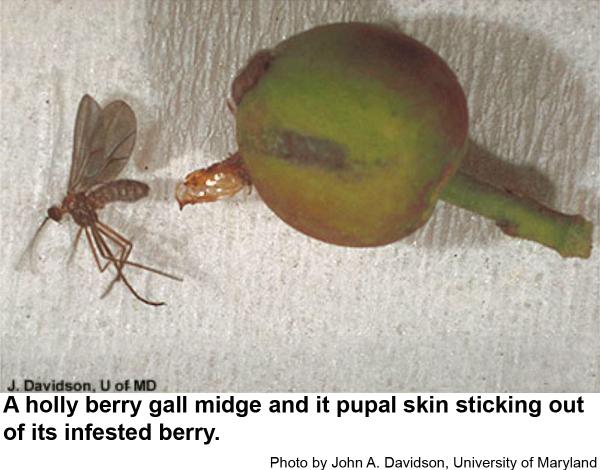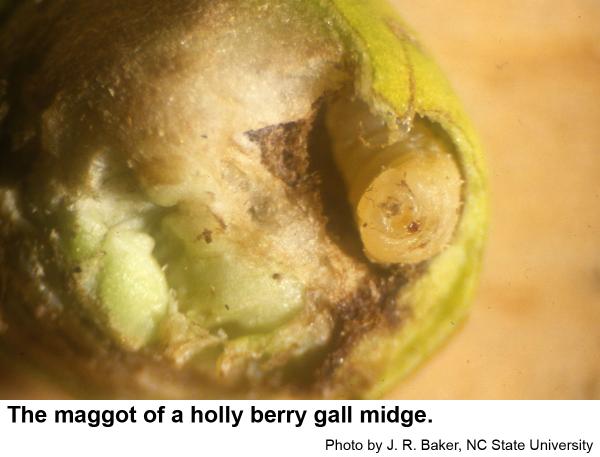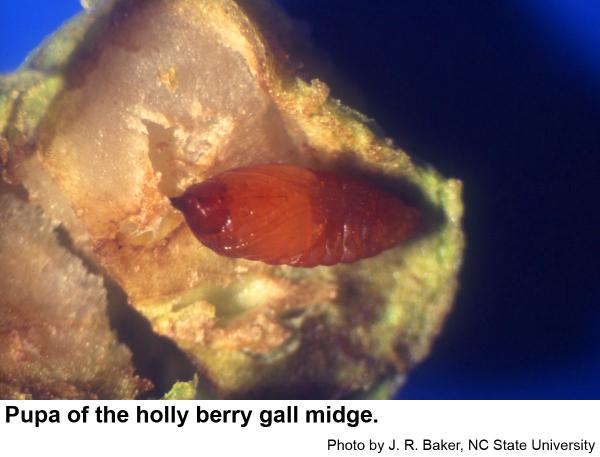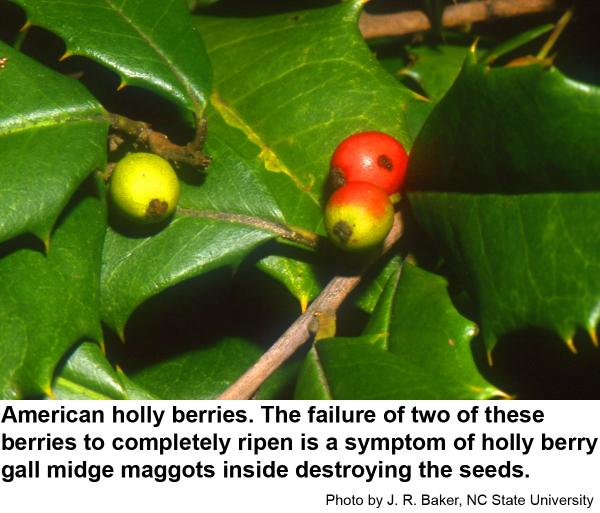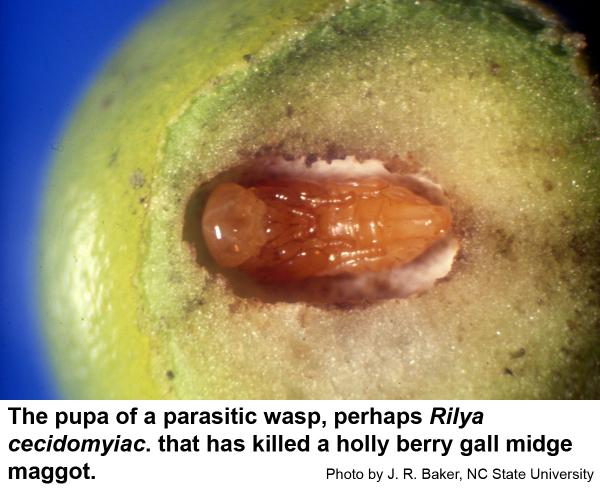Description and Biology
Holly berry gall midge, Asphondylia ilicicola, is a small, gray, mosquito-like fly about 1/8 inch long. These midges lay eggs in the young fruit of hollies while the petals are still present. Tiny, yellow maggots hatch and feed on the seeds inside the developing fruit. The berries grow to near normal size but remain green. The entire maggot, prepupal, and pupal stages are spent in the seed cavity, which completely destroys the seed. Infested berries remain green the entire year, and may be distorted by uneven growth of any seeds not destroyed by maggots. Most berries have only one maggot that destroys only one seed. About a third of the infested berries have two maggots, and a very small percent of berries may have three maggots. Maggots overwinter and become prepupae before pupating inside the berry just as American hollies start to bloom the following spring. Chestnut brown pupae protrude through an exit hole, and another generation of midges soon emerges to mate and lay eggs on berries of flowers that still have petals. In Maryland the larvae pupated in early May and emerged as adults in late May just as American holly flowers opened. We have one generation per year in North Carolina.
Host Plants
The holly berry gall midge has been reported from American holly in which it causes berries of holly to remain green during the fall and winter (some may have a reddish bloom over developing seeds that have not been destroyed by the gall midgle maggots.
Residential Recommendations
Holly berry gall midges have relatively high mortality from parasites and other causes. A tiny wasp parasite, Rilya cecidomyiac, attacks maggots inside the berry. In any one landscape, parasitic wasps may become abundant enough that the holly berry gall midge population may collapse. Sometimes insect populations collapse and do not rebound for several years or even decades because of such natural controls. A major impediment to spraying for holly berry midge control is that the flies emerge as the hollies are blooming and pesticides applied for the midges would also kill bees and other pollinators. However, there may be a window of opportunity just after the female flowers no longer attract bees. Then it would be possible to get some control by applying an insecticide labeled for landscape use. Early blooming trees are more likely to be attacked, and some resistant cultivars are available. Check with your local nursery for cultivars available in your area.
Other Resources
- Holly berry Gall Midge - Trees and Shrubs. Davidson, J. No Date. University of Maryland Extension.
- Life History of Asphondylia ilicicola (Diptera: Cecidonyiidae) a pest of American Holly. Highland, H. A. 1964. J. Econ. Entomol. 57 (1): 81-83.
- The Holly Berry Midge. Schread, J. C. 1971. Circular Connecticut Agricultural Experiment State 243. 3 pp.
- Extension Plant Pathology Publications and Factsheets
- Horticultural Science Publications
- North Carolina Agricultural Chemicals Manual
For assistance with a specific problem, contact your local N.C. Cooperative Extension Center.
This Factsheet has not been peer reviewed.
Publication date: April 3, 2019
Reviewed/Revised: Jan. 11, 2024
Recommendations for the use of agricultural chemicals are included in this publication as a convenience to the reader. The use of brand names and any mention or listing of commercial products or services in this publication does not imply endorsement by NC State University or N.C. A&T State University nor discrimination against similar products or services not mentioned. Individuals who use agricultural chemicals are responsible for ensuring that the intended use complies with current regulations and conforms to the product label. Be sure to obtain current information about usage regulations and examine a current product label before applying any chemical. For assistance, contact your local N.C. Cooperative Extension county center.
N.C. Cooperative Extension prohibits discrimination and harassment regardless of age, color, disability, family and marital status, gender identity, national origin, political beliefs, race, religion, sex (including pregnancy), sexual orientation and veteran status.

